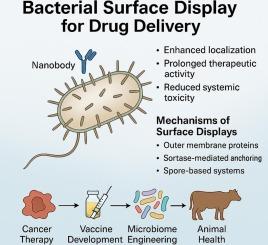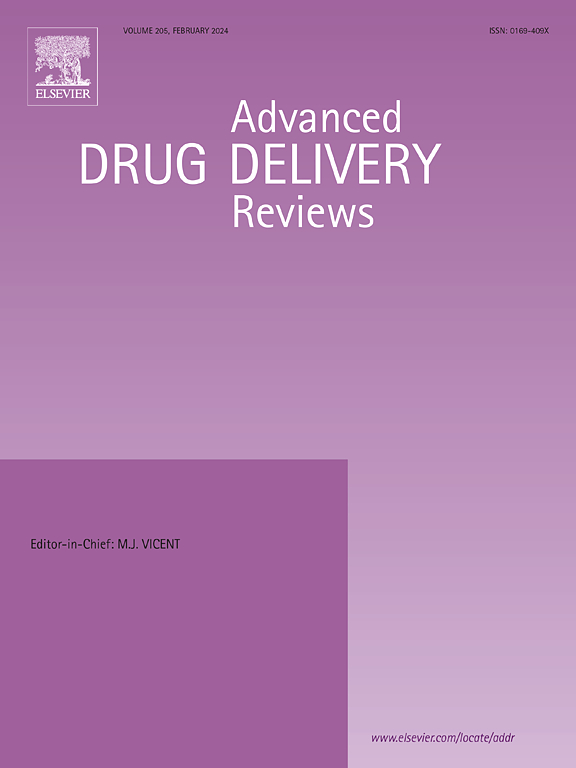重新利用细菌表面展示技术给药
IF 17.6
1区 医学
Q1 PHARMACOLOGY & PHARMACY
引用次数: 0
摘要
细菌由于其固有的适应性、遗传易感性以及与人类微生物组和免疫系统交互的能力,已经成为治疗递送的多功能平台。这篇综述探讨了细菌工程在医学应用中的发展,强调了细菌表面显示技术使药物传递策略成为可能。我们概述了与传统的细菌分泌和基于裂解的递送方法相比,表面显示的优点-例如增强定位,延长治疗活性和降低全身毒性。本文详细介绍了革兰氏阴性菌和革兰氏阳性菌表面展示的关键生物学机制,包括外膜蛋白、排序酶介导的锚定和基于孢子的系统。我们还重点介绍了表面显示的细胞因子、纳米体和免疫调节蛋白在癌症治疗、疫苗开发、微生物组工程和动物健康方面的新应用。将细菌展示与偶联系统和生物传感器相结合的创新方法扩大了这些生物治疗的潜力,以实现精确、灵敏和可编程的干预。此外,我们提出了一个未来的路线图,利用AlphaFold和硅筛选等计算工具来合理识别最佳的外膜锚点,加速下一代表面显示平台的设计。尽管挑战依然存在,包括监管障碍和微生物稳定性,但合成生物学的持续跨学科创新有望将工程细菌转化为临床可行的治疗药物。这篇综述将细菌表面展示定位为靶向药物递送、桥接合成生物学、免疫工程和转化医学的一种强大而尚未开发的模式。本文章由计算机程序翻译,如有差异,请以英文原文为准。

Repurposing the bacterial surface display technology for drug delivery
Bacteria have emerged as versatile platforms for therapeutic delivery, owing to their inherent adaptability, genetic tractability, and ability to interface with the human microbiome and immune system. This review explores the evolution of bacterial engineering for medical applications, emphasizing drug delivery strategies enabled by bacterial surface display technologies. We outline the advantages of surface display—such as enhanced localization, prolonged therapeutic activity, and reduced systemic toxicity—over conventional bacterial secretion and lysis-based delivery methods. The review details key biological mechanisms of surface display in both Gram-negative and Gram-positive bacteria, including outer membrane proteins, sortase-mediated anchoring, and spore-based systems. We also highlight emerging applications of surface-displayed cytokines, nanobodies, and immunomodulatory proteins in cancer therapy, vaccine development, microbiome engineering, and animal health. Innovative approaches combining bacterial display with conjugation systems and biosensors expand the potential of these living therapeutics for precise, responsive, and programmable interventions. Furthermore, we propose a future roadmap that leverages computational tools such as AlphaFold and in silico screening to rationally identify optimal outer membrane anchors, accelerating the design of next-generation surface display platforms. While challenges remain—including regulatory hurdles and microbial stability—continued interdisciplinary innovation with synthetic biology promises to transform engineered bacteria into clinically viable therapeutic agents. This review positions bacterial surface display as a powerful and underexplored modality for targeted drug delivery, bridging synthetic biology, immune engineering, and translational medicine.
求助全文
通过发布文献求助,成功后即可免费获取论文全文。
去求助
来源期刊
CiteScore
28.10
自引率
5.00%
发文量
294
审稿时长
15.1 weeks
期刊介绍:
The aim of the Journal is to provide a forum for the critical analysis of advanced drug and gene delivery systems and their applications in human and veterinary medicine. The Journal has a broad scope, covering the key issues for effective drug and gene delivery, from administration to site-specific delivery.
In general, the Journal publishes review articles in a Theme Issue format. Each Theme Issue provides a comprehensive and critical examination of current and emerging research on the design and development of advanced drug and gene delivery systems and their application to experimental and clinical therapeutics. The goal is to illustrate the pivotal role of a multidisciplinary approach to modern drug delivery, encompassing the application of sound biological and physicochemical principles to the engineering of drug delivery systems to meet the therapeutic need at hand. Importantly the Editorial Team of ADDR asks that the authors effectively window the extensive volume of literature, pick the important contributions and explain their importance, produce a forward looking identification of the challenges facing the field and produce a Conclusions section with expert recommendations to address the issues.

 求助内容:
求助内容: 应助结果提醒方式:
应助结果提醒方式:


